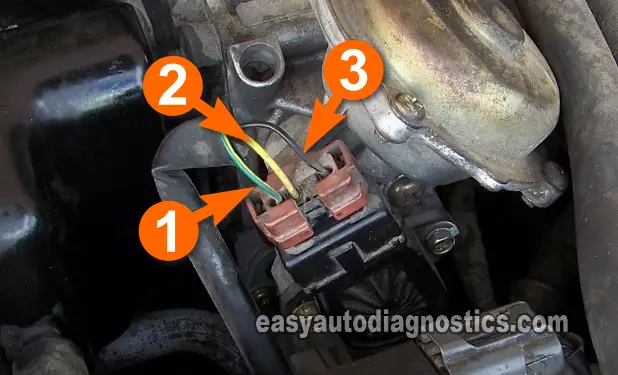
Testing the throttle position sensor (TPS) on your 2.4L SOHC equipped Mitsubishi car (or Chrysler Sebring or Dodge Stratus) can be done in three easy steps with a simple multimeter.
You don't need a scan tool to do it and this article will walk you thru' the entire diagnostic and troubleshooting process.
You'll be able to confidently conclude, at the end of the TPS test, that the throttle position sensor is either good or bad.
If you're wondering if this tutorial applies to your specific Mitsubishi (or Chrysler/Dodge) vehicle, you'll find a complete list of Mitsubishi, Chrysler and Dodge vehicles this tutorial applies to in the box titled 'Applies To' on the right-hand column.
Contents of this tutorial:
- Symptoms Of A Bad Mitsubishi TPS Sensor.
- What Tools Do I Need?
- Circuit Descriptions Of The 2.4L (SOHC) Mitsubishi TPS.
- How Does The Mitsubishi TPS Work?
- TEST 1: Testing The Power (5 Volt) Circuit.
- TEST 2: Testing The Sensor Return (Ground) Circuit.
- TEST 3: Testing The TP Signal.
- TEST 4: TPS Code Won't Go Away.
![]() You can find this tutorial in Spanish here: Cómo Probar El Sensor TPS (2.4L Mitsubishi) (at: autotecnico-online.com).
You can find this tutorial in Spanish here: Cómo Probar El Sensor TPS (2.4L Mitsubishi) (at: autotecnico-online.com).
Symptoms Of A Bad Mitsubishi TPS Sensor
Usually you'll experience several things at once when the TPS goes bad on your Mitsubishi vehicle (or Chrysler Sebring or Dodge Stratus). Along with the check engine light being 'on' on your instrument cluster, you'll also notice one or several of the following:
- TPS diagnostic trouble codes (DTCs) stored in the vehicle's computer's memory.
- P0121: Throttle position sensor circuit range/performance problem.
- P0122: Throttle position sensor circuit low input.
- P0123: Throttle position sensor circuit high input.
- Really bad gas mileage.
- Transmission does not shift out of second gear.
- No power as you accelerate the vehicle.
- Hesitation when you step on the accelerator pedal.
What Tools Do I Need?
As mentioned at the beginning of the article, you don't need an automotive scan tool to diagnose and troubleshoot the TPS on your Mitsubishi car. You do need:
- A multimeter. It can be digital or an analog one although I recommend a digital multimeter (don't have a digital multimeter? Need to buy one? Click here to see my recommendations: Buying A Digital Multimeter For Automotive Diagnostic Testing).
- A helper to help you with TEST 3.
- A repair manual for any remove and replace info that I don't include in this article.
Circuit Descriptions Of The 2.4L (SOHC) Mitsubishi TPS

This throttle position sensor is a three wire sensor. One wire gets power, another Ground and the other is the throttle position output signal wire. Below are the specifics of each in conjunction with the photo in the image viewer on the right:
- Circuit labeled 1:
- Power Circuit (5 Volts from PCM).
- Circuit labeled 2:
- Throttle Position (TP) Signal Circuit.
- Circuit labeled 3:
- Ground Circuit (Provided by PCM internally).
I'm gonna' make one very important recommendation to you when testing the signals of each wire. And that is to not probe the front of the female terminal of the TPS connector. It's best to use a tool like a back probe or a wire piercing probe on the connector. You can see an example of this tool here: Wire Piercing Probe.
One last observation: these three circuits go directly to the PCM. So you need to be careful not to short the Ground wire to battery power (12 Volts) or you'll fry the PCM.
How Does The Mitsubishi TPS Work?
Here's some very basic working theory that'll make it easier to understand the logic behind the three tests you're about to do. When you turn the key to crank and start your Mitsubishi car (or Chrysler Sebring or Dodge Stratus), this is what happens:
- The PCM (Powertrain Control Module=Fuel Injection Computer) feeds the TPS power (which in this case is 5 Volts DC) and Ground.
- Once the vehicle starts and the engines is idling with the throttle closed.. the throttle position sensor sends the PCM a voltage signal of about 0.6 Volts DC.
- Once you step on the accelerator pedal and the throttle opens, the TP sensor's voltage signal increases and this is how the PCM knows to dump (inject) more fuel into the cylinders, advance ignition timing, start shifting the automatic transmission, etc.
- As you let go off the gas pedal (accelerator pedal) and the throttle closes, the TP sensor decreases the voltage signal to the PCM, which returns to its base voltage signal, till you step on the accelerator pedal to move the vehicle and the cycle begins again.
Pretty simple stuff, no? Well testing it is just as simple. Since you'll be working in the engine compartment, no need to tell you (but I'm gonna' tell you anyway) to be alert and be very careful. Use common sense and take all necessary safety precautions. OK, let's get this show on the road.
TEST 1: Testing The Power (5 Volt) Circuit

OK, the first test, in your TPS diagnostic and troubleshooting, is to see if the throttle position sensor is indeed getting power.
Power comes in the form of 5 Volts. This voltage is provided internally by the PCM.
Alright, here's what you'll need to do:
- Once you have warmed up the engine, turn it off and remove any plastic covers that may be hiding the TPS from view and access.
- If necessary, remove the air duct that connects the throttle body to the mass air flow sensor assembly.
- Put your multimeter in Volts DC mode (don't have a digital multimeter? Need to buy one? Click here to see my recommendations: Buying A Digital Multimeter For Automotive Diagnostic Testing).
- With the red multimeter test lead, and an appropriate tool, probe the circuit labeled with the number 1 in the photo.
- The best way to probe this circuit is with a Wire Piercing Probe, to see what one looks like, click here: Wire Piercing Probe.
- Connect the black multimeter test lead to a good and clean Ground point on the engine or directly on the negative battery terminal.
- Turn the key to its ON position but do not start the engine.
- Your multimeter should read 4.5 to 5 Volts.
Let's see what your multimeter test result means:
CASE 1: The multimeter registered 4.5 to 5 Volts. This is the correct and expected test result.
So far so good since this confirms that the PCM on your Mitsubishi (or Chrysler Sebring or Dodge Stratus) is feeding power to the TPS. The next step is to see if it's also feeding Ground, go to: TEST 2: Testing The Sensor Return (Ground) Circuit.
CASE 2: The multimeter DID NOT register 4.5 to 5 Volts. Without these 5 Volts the TPS won't work.
This usually happens when the fuel injection computer is NOT supplying power to the TPS. This missing voltage could be the result of an open-circuit problem in the circuit or the PCM may be fried.
Altho' testing these two conditions are beyond the scope of this article, you have now eliminated the throttle position sensor (TPS) on your Mitsubishi vehicle as being the cause of the problem and/or the TPS diagnostic trouble code (DTC) lighting up the check engine light (CEL).
